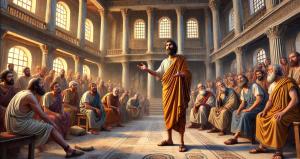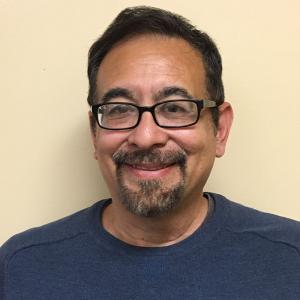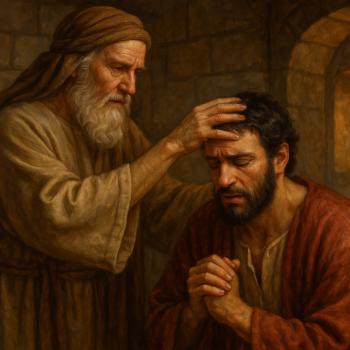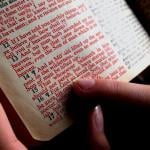An often overlooked but significant passage in Acts speaks of the Apostle Paul in the “hall of Tyrannus” when staying in Ephesus. After boldly proclaiming the kingdom of God in the synagogue for three months, some became hardened and spoke against the followers of Christ. In response, Paul “having departed from them, he took away his disciples, reasoning every day in the lecture hall (school) of Tyrannus. And this took place for two years so that all those dwelling in Asia heard the word of the Lord, both Jews and Greeks” (Acts 19:9b–10).
A text variation* includes that Paul used the facility daily “from the fifth to the tenth hour,” (11 am to 4 pm). Even if this variation proves inauthentic, it provides perhaps a good estimation of when Paul would teach—at a siesta time in which the hall would not normally be used (See Eckhard Schnabel, Acts, 792).
What is the result of Paul teaching daily for two years? Before answering this question, we must first step back and explore the significance of the use of this school as Paul’s communication venue.

The Schole of Tyrannus
Tyrannus was apparently an Ephesian, whether a lecturer or owner of the facility. The more important term is the “school” or “lecture hall”: scholê (σχολή). When used as a noun the Greek word can refer to a time of leisure, break, or cessation, but in another sense it means a school, lecture, or place of lecture. The phrase “scholas legein” (σχολὰς λέγειν) means, “to hold lectures” (Epictetus Diatribai 4.11.35), and Plutarch and Josephus provide us with examples of the term as a venue in which sophisticated intellectual schooling takes place (Plutarch, On Exile 14.1[Moralia 605a]; Josephus, Apion 1.53).**
Now back to Acts 19:9–10:
Paul’s use of the lecture hall and the spread of the gospel
This school facility appeared to be open to the public even though Paul uses it during the afternoons to teach with further instruction his disciples taken from the synagogue. The apostle taught daily there for two years, and God also did unusual miracles through Paul during this period (Acts 19:11–12).
This seems to be the same period of time when he writes to the Corinthians that an effectual door has opened to him in Ephesus (1 Cor 16:8–9). In part he seems to be referring to the use of this hall as a great opportunity for him not only to instruct his disciples but to advance the gospel. The “word of the Lord” that all the region of Asia was hearing through Paul’s lessons is referencing the gospel (cf. Acts 4:29; cf. Schnabel, Early Christian Mission, 1:794).
Although Luke may have a tendency to overstate things by his use of the word “all,” the text assures that Paul had quite a number of visitors drop in to hear him teach, whether local people or travelers. The locals would report back to their acquaintances what the apostle had taught, and the travelers would do the same once back in their respective cities. Messages from travelers about Christ, incidentally, is how congregations were first formed in Antioch and apparently Rome (e.g., Acts 11:19–22).
Results of the lectures
In this way the gospel message may have spread from Ephesus to surrounding cities in the region of Asia Minor. We notice the plural “churches” (ἐκκλησίαι) in that area already in 1 Cor 16:19. These ekklesiai perhaps included some of the congregations in Ephesus’s neighboring towns in Revelation 2–3 (such as Colossae, Smyrna, Laodicea, and Philadelphia), and Troas (Acts 20:5, 7–11; 2 Cor 2:12), Miletus (20:17), and Magnesia and Tralles (mentioned by Ignatius of Antioch; cf. Schnabel, Early Christian Mission, 1:794).
Some cross-pollination north into Bithynia, some of the congregations that 1 Peter addresses, also may have taken place at this time.
We also should not underestimate the disciples in Ephesus who probably did some evangelism to neighboring cities as well. In any case, they learned how to gospelize through Paul’s dedicated instruction.
Doubtless, Paul tuned up his communication skills at this time. One suspects his use of ancient diatribe—in which one may pose an imaginary interlocutor raising questions against one’s discourse—was prompted here. We find such discourse in Romans 3:1–9, for example. Such questions and responses probably originated from actual experiences the apostle encountered when speaking.
Conclusion
All this seems to have taken place as a result of Paul’s faithful and persistent teaching and proclaiming of the gospel through the public venue of this school of Tyrannus. Also, his determination to follow-up on his converts so as to equip them to become committed disciples must factor in on this.
As James Dunn affirms regarding this period of Paul’s ministry in Ephesus: “For Paul to have lectured for two years in the same setting indicates an extensive range of subjects, texts and traditions covered during that period. We have to envisage a large syllabus covering exposition of many Scriptures, instruction in Jesus tradition, and elaboration of the characteristic Pauline themes that we know of from his letters. This is not to say that Ephesus should be seen as marking a major development in Pauline theology. What we can envisage, however, is a systematic presentation of his gospel and its outworking, already developed perhaps in more piece-meal fashion in less sustained preaching and teaching” (Dunn, Beginning from Jerusalem, 769).
Notes
* The primary manuscripts supporting this variant are D (Codex Bezae), Syriac Harklensis, and Codex Gigas (13th c.).
** See more examples in lexicon sources, such as Franco Montanari, The Brill Dictionary of Ancient Greek, s.v.; and Bauer, Danker, Arndt, and Gingrich (BDAG), 982.














